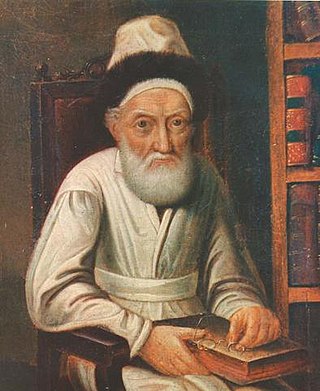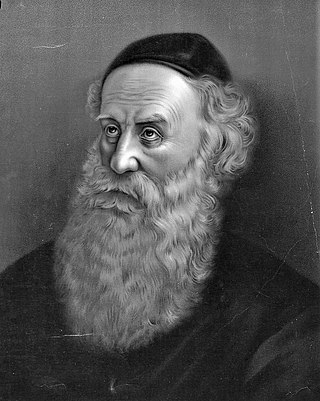
Meshullam Zalman Schachter-Shalomi, commonly called "Reb Zalman", was one of the founders of the Jewish Renewal movement and an innovator in ecumenical dialogue.

Chabad, also known as Lubavitch, Habad and Chabad-Lubavitch, is a branch of Orthodox Judaism, originating from Eastern Europe and one of the largest Hasidic dynasties. Chabad is one of the world's best-known Hasidic movements. It is one of the largest Hasidic groups as well as one of the largest Jewish religious organizations in the world. Unlike most Haredi groups, which are self-segregating, Chabad mainly operates in the wider world and it caters to secularized Jews.

A Rebbe or Admor is the spiritual leader in the Hasidic movement, and the personalities of its dynasties. The titles of Rebbe and Admor, which used to be a general honor title even before the beginning of the movement, became, over time, almost exclusively identified with its Tzadikim.

Menachem Mendel Schneersohn also known as the Tzemach Tzedek was an Orthodox rabbi, leading 19th-century posek, and the third rebbe of the Chabad Lubavitch Hasidic movement.

Shneur Zalman of Liadi, commonly known as the Alter Rebbe or Baal Hatanya, was a rabbi as well as the founder and first Rebbe of Chabad, a branch of Hasidic Judaism. He wrote many works, and is best known for Shulchan Aruch HaRav, Tanya, and his Siddur Torah Or compiled according to the Nusach Ari.

The Tanya is an early work of Hasidic philosophy, by Rabbi Shneur Zalman of Liadi, the founder of Chabad Hasidism, first published in 1796. Its formal title is Likkutei Amarim, but is more commonly known by its first Hebrew word tanya, which means "it has been taught", where he refers to a baraita section in "Niddah", at the end of chapter 3, 30b. Tanya is composed of five sections that define Hasidic mystical psychology and theology as a handbook for daily spiritual life in Jewish observance.

Sholom Dovber Schneersohn was the fifth rebbe of the Chabad-Lubavitch chasidic movement. He is known as "the Rebbe Rashab". His teachings that encouraged outreach were further developed later.

Kehot Publication Society is the publishing division of the Chabad-Lubavitch movement.
Dovber Schneuri was the second Rebbe of the Chabad Lubavitch Chasidic movement. Rabbi Dovber was the first Chabad rebbe to live in the town of Lyubavichi, the town for which this Hasidic dynasty is named. He is also known as the Mitteler Rebbe, being the second of the first three generations of Chabad leaders.

Yoel Kahan was a senior Chabad rabbi who worked for the Lubavitcher Rebbe, Menachem Mendel Schneerson.

Hillel HaLevi Malisov of Paritch, a levite by birth, commonly known as Reb Hillel Paritcher (1795-1864) was a famous Orthodox Jewish Chabad Rabbi born in Khmilnyk, Ukraine. Specifically, he served as a Mashpia and communal rabbi in the towns of Paritch, near Minsk, Russia, and Bobroisk, Belarus. He was considered exceptional in his scholarship and piety, and is referred to as a Tzadik, and even as a "half Rebbe."

Shneur Zalman Moishe HaYitzchoki, usually known familiarly as Reb Zalman Moishe,, was an Orthodox Jewish Chabad-Lubavitch Rabbi in pre-war Europe, and towards the end of his life, in the Land of Israel. He served as a Mashpia and shochet. He was a follower of the Rebbe Rashab and the Rebbe Rayatz.

Chabad offshoot groups are those spawned from the Chabad Hasidic Jewish movement. Many of these groups were founded to succeed previous Chabad leaders, acting as rivals to some of the dynastic rebbes of Chabad. Others were founded by former students of the movement, who, in forming their own groups, drew upon their experiences at Chabad.

Chabad philosophy comprises the teachings of the leaders of Chabad-Lubavitch, a Hasidic movement. Chabad Hasidic philosophy focuses on religious concepts such as God, the soul, and the meaning of the Jewish commandments.

Chabad customs and holidays are the practices, rituals and holidays performed and celebrated by adherents of the Chabad-Lubavitch Hasidic movement. The customs, or minhagim and prayer services are based on Lurianic kabbalah. The holidays are celebrations of events in Chabad history. General Chabad customs, called minhagim, distinguish the movement from other Hasidic groups.

Siddur Im Dach is a Hasidic prayer book written by Rabbi Schneur Zalman of Liadi, the first Rebbe of the Chabad-Lubavitch movement. Accompanying the prayers are Hasidic discourses written by Rabbi Schneur Zalman.

Yehoshua Mondshine was an Israeli rabbi, scholar, researcher and historian associated with the Chabad-Lubavitch, Hasidic movement. Mondshine worked as a librarian and bibliographer at the National Library of Israel in Jerusalem.

Yisroel Jacobson (1895-1975) was a Chabad Hasidic rabbi and the representative of the sixth Chabad rebbe, Yosef Yitzchak Schneersohn, to the United States during the 1920s and 1930s. He was one of the first Lubavitcher activists to arrive in to the United States. He was born in Russia and migrated to the United States in 1925.
Yosef Yitzchak "Yossi" Jacobson, also known as YY Jacobson, is an American Chabad rabbi and speaker from Monsey, New York.

Hasidic Judaism in Lithuania is the history of Hasidic Judaism and Hasidic philosophy in Lithuania and parts of modern-day Belarus. Hasidic Judaism in Lithuania began with R. Aaron Perlow of Karlin (Karalin) (1736–1772), R. Menachem Mendel of Vitebsk (1730?–1788) R. Shneur Zalman of Liadi (Lyady) (1745–1812) and to a lesser extent R. Hayim Haykl of Amdur (Indura), all of whom were disciples of R. Dov Ber of Mezeritch (Mezhirichi), who in part was the successor to the R. Israel Baal Shem Tov who founded Hasidic Judaism in Western Ukraine. In its earliest years, Lithuanian Hasidism suffered immense persecution by the Lithuanian Misnagdic rabbinate, who attempted to ban and excommunicate Hasidism on several occasions in Lithuania beginning with R. Elijah b. Solomon Zalman of Vilna (1720–1797), who was the earliest disseminator of anti-Hasidic thought which flourished in Lithuania.













